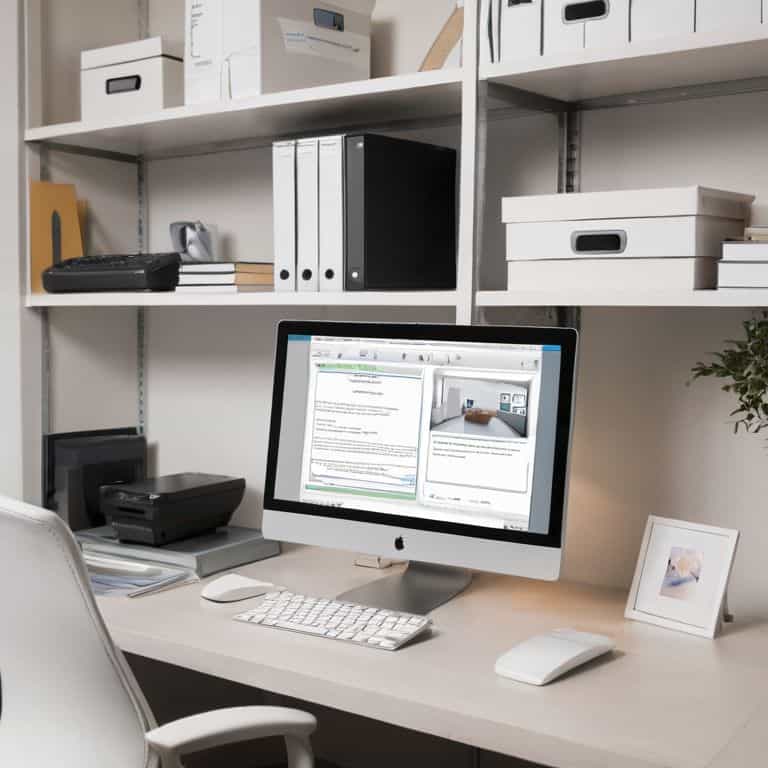I still remember the day I decided to start going paperless at home. I was overwhelmed by the sheer amount of clutter that seemed to multiply on my desk and in my filing cabinets. As someone who’s passionate about creating serene spaces, I knew I had to make a change. The myth that ditching paper would be a complicated, time-consuming process was a major hurdle for me. But, as I delved deeper into the world of digital organization, I discovered that it’s actually a simple yet powerful step towards creating a more peaceful living space.
In this article, I’ll share my personal experience and expertise on going paperless at home, providing you with practical tips and honest advice on how to make the transition smoothly. You’ll learn how to streamline your paperwork, digitize your documents, and create a system that works for you. My goal is to help you create a space that’s not only clutter-free but also calming and organized, allowing you to focus on what truly matters. By the end of this guide, you’ll be equipped with the knowledge and confidence to start your own paperless journey and enjoy the serenity that comes with it.
Table of Contents
Guide Overview: What You'll Need

Total Time: 1 hour 30 minutes
Estimated Cost: $20 – $50
Difficulty Level: Easy
Tools Required
- Computer (with internet connection)
- Scanner (optional)
- Tablet or Smartphone (for digital note-taking)
Supplies & Materials
- Cloud Storage Subscription (e.g., Google Drive, Dropbox)
- Digital Note-taking App (e.g., Evernote, OneNote)
- File Organization Software (e.g., digital file cabinets)
Step-by-Step Instructions
- 1. First, let’s start by assessing your paper usage at home. Take a week or two to observe and note down all the types of paperwork that come into your home, from bills and receipts to newsletters and junk mail. This will give you a clear idea of what you’re dealing with and help you identify areas where you can make a significant impact by going digital.
- 2. Next, set up a digital infrastructure that will support your paperless journey. This can include investing in a scanner, setting up cloud storage, and creating digital folders for different types of documents. I recommend using a service like Dropbox or Google Drive to store your files, as they offer a high level of security and accessibility.
- 3. Now, it’s time to digitize your documents. Start by scanning all your important papers, such as identification documents, insurance policies, and tax returns. You can use a scanner or a mobile app like CamScanner or Scanbot to make the process easier. Be sure to save your scanned documents in clearly labeled folders, so you can easily find what you need.
- 4. One of the most significant advantages of going paperless is the ability to automate recurring tasks. Look into setting up automatic bill payments and digital subscriptions to reduce the amount of paperwork you receive. You can also use services like Paperless Post or Evite to send digital invitations and cards, reducing the need for physical mail.
- 5. To further reduce your paper usage, consider switching to digital notes. Instead of using sticky notes or paper notebooks, try using a note-taking app like Evernote or OneNote. These apps allow you to organize your notes, add tags and reminders, and access them from any device.
- 6. Another area where you can make a significant impact is by reducing junk mail. Register with the National Do Not Mail List or use a service like OptOutPrescreen to stop receiving unwanted mail. You can also contact companies directly and ask them to remove you from their mailing lists.
- 7. As you continue on your paperless journey, it’s essential to establish a maintenance routine. Set aside time each week to review your digital files, update your folders, and ensure that everything is organized and easily accessible. This will help you stay on track and prevent digital clutter from building up.
- 8. Finally, don’t forget to back up your digital files regularly. Use an external hard drive or a cloud backup service like Backblaze to ensure that your documents are safe in case of a technical issue or data loss. This will give you peace of mind and protect your important documents from being lost forever.
Going Paperless at Home

As I continue on my journey to create a digital sanctuary, I’ve come to realize the importance of scanning photos and documents. This simple step has allowed me to preserve cherished memories while reducing physical clutter. By digitizing my paperwork, I’ve also been able to take advantage of electronic signature tools, making it easier to manage documents and sign important papers remotely.
One of the most significant challenges I faced when transitioning to a paperless system was finding the best cloud storage for documents. After researching and testing various options, I found a service that meets my needs for security, accessibility, and ease of use. This has been a game-changer for my digital document organization, allowing me to access important files from anywhere and share them with others when needed.
By implementing these strategies, I’ve been able to significantly reduce paper clutter at home, creating a more peaceful and organized living space. As I look around my newly decluttered office, I feel a sense of serenity wash over me, knowing that I’ve taken control of my physical and digital space. This sense of calm has also translated to other areas of my life, allowing me to focus on what truly matters.
Reducing Paper Clutter With Scanning
To truly reduce paper clutter, scanning is a crucial step. I’ve found that investing in a good scanner can be a lifesaver. It allows me to digitize important documents, receipts, and even kids’ artwork, freeing up physical space and reducing the stress of dealing with piles of paper. By scanning these items, I can then store them digitally, making it easier to find what I need when I need it.
This process has been incredibly therapeutic for me, and I’ve seen the same effect on my clients. By letting go of physical clutter, we can clear our minds and focus on what truly matters. Scanning also helps me implement my “purpose or a place” rule, ensuring that every digital file has a designated home, just like every physical object in my home.
Simplifying Digital Document Organization
As I delved into the world of digital documents, I realized that organization is key to maintaining a clutter-free mind. I’ve found that creating clear categories and folders for my digital files has been a lifesaver. By designating specific spaces for different types of documents, I can easily locate what I need without feeling overwhelmed. This simple system has allowed me to breathe a sigh of relief, knowing that my digital life is just as tidy as my physical one.
I’ve also adopted a “home for everything” approach to my digital files, ensuring that each document has a designated spot. This mindset has been a game-changer, allowing me to quickly find what I need and maintain a sense of calm in my digital space. By simplifying my digital document organization, I’ve been able to reduce stress and increase productivity, creating a more peaceful and organized life.
Embracing a Paperless Sanctuary: 5 Key Tips to Get You Started
- Designate a digital hub: Choose a specific device or platform where all your digital documents will be stored, making it easy to access and manage your files
- Implement a scanning routine: Set aside time each week to scan and digitize any physical documents that have accumulated, using a scanner or a mobile app
- Opt for digital bills and statements: Contact your service providers to switch to digital bills and statements, reducing the amount of paper mail you receive
- Create a simple filing system: Organize your digital documents into clear categories and folders, making it easy to find what you need when you need it
- Schedule regular digital backups: Set up automatic backups of your digital files to ensure your information is safe and secure, giving you peace of mind in your paperless journey
Key Takeaways for a More Serene Home
By embracing digital documents and letting go of paper clutter, you can significantly reduce stress and create a sense of calm in your living space
Implementing a simple scanning routine and organizing your digital files can help you quickly locate important documents, saving you time and mental energy
Creating a paperless home is not just about efficiency, but also about cultivating a mindset that values simplicity and clarity, leading to a more peaceful and organized life
Embracing the Digital Sanctuary
As we shed the weight of paper clutter, we’re not just freeing up physical space – we’re also unshackling our minds from the constant barrage of visual noise, allowing us to breathe deeper, think clearer, and live more intentionally.
Nathan Reed
Embracing a Paperless Sanctuary

As we’ve explored the journey of going paperless at home, it’s clear that this transition is about more than just reducing clutter – it’s about creating a serene environment that fosters clarity and calmness. We’ve discussed the importance of simplifying digital document organization and the role of scanning in reducing paper clutter. By implementing these strategies, individuals can begin to experience the profound impact that a paperless home can have on their mental and emotional well-being.
As you embark on your own paperless journey, remember that every small step counts, and the goal is not to achieve perfection but to move closer to a space that truly feels like a sanctuary. By embracing this lifestyle, you’re not only contributing to a more organized and peaceful living environment, but you’re also investing in your mental health – and that’s a gift that will continue to unfold long after the paper is gone.
Frequently Asked Questions
How do I decide what documents to scan and what to shred when going paperless at home?
When deciding what to scan and what to shred, I recommend the ‘purpose or place’ test. Ask yourself: does this document serve a purpose or have a designated place in my digital life? If not, it’s likely a candidate for shredding. Be ruthless – if you haven’t referenced it in a year, it’s probably safe to let it go.
What are some reliable digital tools for organizing and storing sensitive documents like tax returns and insurance policies?
For sensitive documents, I swear by tools like Evernote and Dropbox. They offer robust security features and intuitive organization systems, allowing me to easily categorize and retrieve files like tax returns and insurance policies. I also recommend exploring password-protected notes and folders for added peace of mind.
Will going paperless at home really make a significant difference in reducing clutter and increasing productivity?
I’ve seen it firsthand – ditching paper clutter can be a total game-changer. By going digital, you’ll not only free up physical space, but also reduce mental fatigue from dealing with paperwork. It’s amazing how a clear desk and a clear mind can boost productivity and overall sense of calm. Give it a try and you’ll be surprised at the difference it makes.
